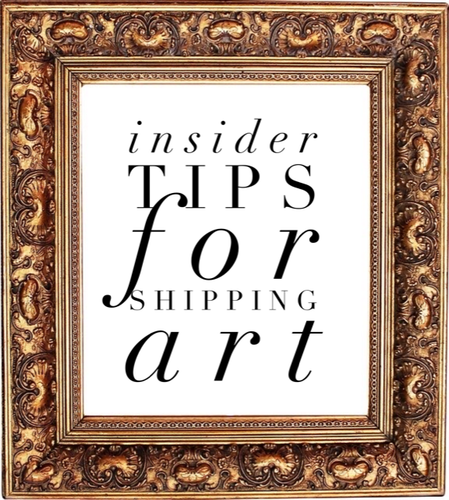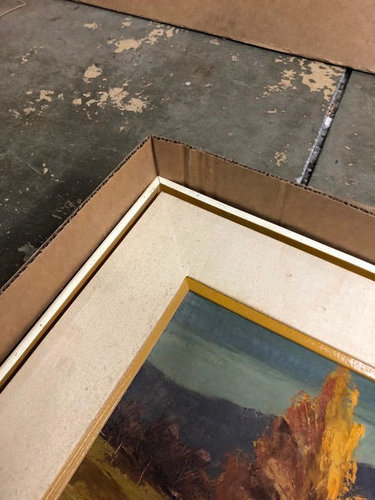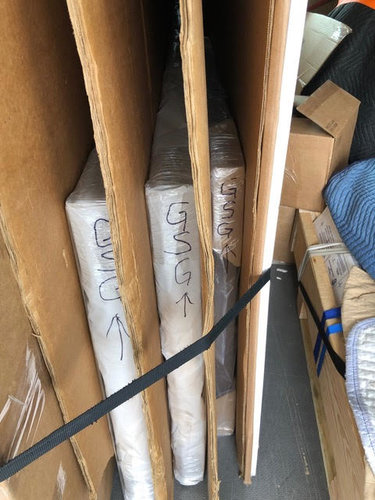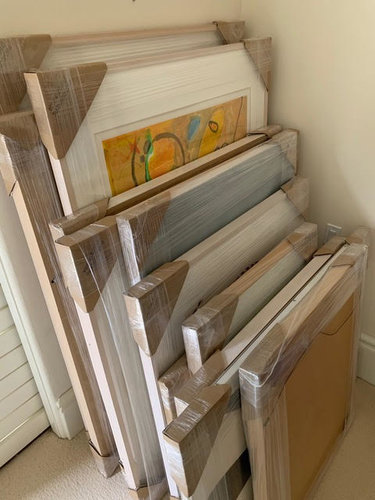by Carolyn Edlund
Expert Bob Sorrentino of fine art shipping service iTransport4u shares best practices for getting artwork safely and securely to its destination.

Want to know the best way to ship your artwork? Ask an expert. I reached out to Bob Sorrentino, president of iTransport4u, which brings “an elevated level of safety, reliability, courtesy and genuine human interaction to galleries, artists, museums, and collectors all around the continental U.S. with a mission to provide distinguished customer service tailored to clients’ individual needs.” We spoke about common questions and concerns artists have on the subject.
AS: How can artists pack their artwork safely for shipping?
BS: With reference to what materials can or cannot touch the face of an artist’s work, I believe each artist knows their work the best. Having said that, here are some basic packing suggestions for the more sensitive mediums artists work in.
A highly lacquered or resin-type finish should only have nonabrasive, noninteractive packing materials like microfiber cloth touching the surface. Bubble wrap, plastic sheeting, cardboard, sponge, styrofoam, or packing peanuts should not be in contact with the surface. They can damage the glossy finish.
An alternative way to pack all mediums of art that require no surface contact would be to utilize a shadow box or collar packing process. This style of packing insures that nothing touches the face of the art. The shadow box or collar is made 1″ to 2″ deeper than the art and attached to the back, keeping the face of the art suspended in air. This is also an excellent way to protect a three-dimensional painting.
For oils, acrylics, watercolors and printed posters whose surfaces are not sensitive to touch, a simple 6mm plastic wrap and a cardboard face with protective corners is a good way to send your art with a reputable art transportation service.

Example of a collared painting
AS: What about large or very fragile work? Or mediums like encaustic or pastel that might be easily damaged?
The transportation company’s ability to handle large work is obviously limited by the size of the cargo area. Box trucks are large enough, but are not designed to have a smooth ride. This is just part of the freight industry’s DNA. They are built for crated freight, not delicate or fragile art that requires the personal touch of an art handler transportation service. Even air ride suspensions suffer from vibrations and bouncing compared to the car-like ride of the new vans currently available. Mercedes Benz’s Sprinters, Ford Transits and Dodge’s Pro-Master vans offer a smoother, safer ride. With an art transportation company, it is less likely that the art would be transferred multiple times from truck to truck, as is the case with the large carriers.
Fragile work like delicate pastels behind glass or encaustic paintings, requires specific packing. Due to encaustics’ temperature-sensitive nature, it is best to enclose them in half-inch styrofoam sheets on all six sides (front, back and four sides). The styrofoam packing helps protect the encaustic by insulating it from quick temperature changes. It is best if the transportation service vehicle’s cargo area is temperature controlled, as keeping the contents between 40-80 degrees is essential.
One of the biggest challenges for pastels behind glass is that some of the pastel dust can separate from the surface of the art from too much handling or vibration. This loose dust ends up inside the glass at the bottom of the frame. In order to avoid shaking dust loose from the face of the art, insulation tubes on the frame can reduce these vibrations during transportation. These tubes are also ideal for transporting artwork with glass, aluminum or plaster edges that are not inside a frame.
AS: Is it safe to trust major national shippers to handle artwork in general?
BS: All of these recommendations are geared toward a trusted, well trained, industry specific art transportation company that provide delivery services.
The big corporate national shippers are not trained, considerate, encouraged or mindful of the contents of the boxes they carry. They are more concerned with profitability, designed for cost effective shipping for consumer items that aren’t fragile or require special handling.

Proper painting dividers in cargo area
AS: What do artists need to know about insurance on artwork being shipped?
BS: The big corporate national carriers have a very limited policy for insuring fine art, if at all. Their small print includes numerous ways to limit their liability. They include language like not covering over a certain value of fine art. The transportation of art does not fit their service style, business strategy, or ideal customer. They just are not customer-service oriented about paying out insurance claims.
A reputable art transportation company can offer insurance that, if necessary, will give you good resolution, whether it be repair or replacement.
For studio artists or galleries or museums that have a blanket liability insurance policy, these policies may include what is called “in-transit” coverage. This portion of their policy is usually 25% of the total coverage. I have met many clients who were not aware of this part of their policy.

Example of frame-on-frame stacking, where no one corner is touching the center of the painting next to it.
AS: What advice do you have to make packing and shipping artwork easier and more cost effective?
BS: Using new pristine packing materials is essential to indicate that the package, when given to the driver, is in good condition. Packing with used materials makes it difficult to determine when or if damage has occurred while in transit.
Having artwork that is of standard sizes makes buying materials more cost effective. Also using similar sized frames makes it easier and safer to pack in the transportation vehicle. Frame-on-frame packing eliminates pressure points in the middle of the adjacent painting.
Having a designated area with the proper materials and tools for packing your specific art will help to insure successful shipments.
AS: What would you consider to be the top best practices for shipping art?
BS: As a 20+ year veteran in the art transportation industry, here are my top 5 recommendations for shipping art:
- The art is finished and dry. Do not ask anyone to transport wet paintings or unfinished art.
- The proper materials and practices have been used to prepare the art for transport.
- Give the art shuttle service all the necessary info about the art, i.e. medium, fragility, and any special instructions on how to handle the art. Give current, accurate and complete contact info for the recipient for smooth logistics.
- Make sure all documents are present and correct, including inventories and descriptions that coincide with what is being shipped.
- Take time getting to know the company with whom you are trusting your shipment. Remember, this company is representing you when they arrive at the delivery site. Your client perceives them as an extension of you.
For more information about fine art shipping, contact iTransport4u.


Info on shipping textiles ie banners please
Depending on what the banner is made of, ie paper, vinyl, woven fabric, even carpets are best transported when rolled around the out side of a large tube. As much as 10″ to 14″ in diameter depending on the flexibility of the banner. After rolling the banner around the tube it should be covered by a protective layer, packing blanket or sponge wrap is good. The final step is wrapping the whole thing in shrink wrap to hold it all togther.
Info on shipping oversized stretched canvas acrylic paintings that cannot be rolled